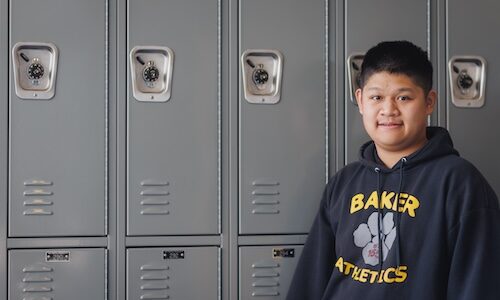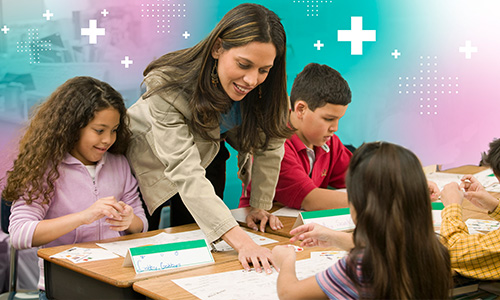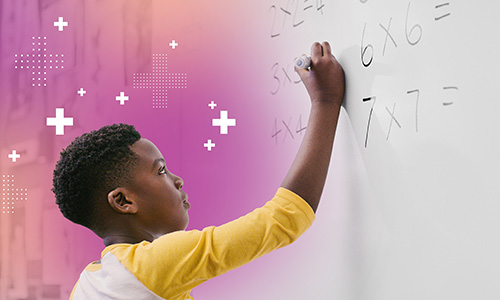
This year, I tried something revolutionary in my middle school math class: I took away their pencils, rearranged their chairs in a circle, and had a conversation. About math.
I didn’t invent this strategy. Mathematical “formative conversations” are, in the words of NWEA professional learning consultant Nick Joe, “the process of simply gathering information about what’s going on in the student’s brain.” “Formative” is a word we hear a lot in the education space, yet I think it warrants elaboration: “formative” implies anything that serves as an ongoing check-in, as opposed to “summative,” which usually describes an end-of-learning assessment.
Every math teacher wants active, spirited discussion around mathematical concepts, but sometimes, the right-and-wrong vibe of math can make conversations seem fraught. And yet, hearing students’ math conceptualizations is the best way to access their knowledge and let students grow each other.
NWEA formative conversations starters equip teachers to host these discussions in our classrooms, empowering us to listen with intention and discover our students’ deep mathematical understanding (which is, of course, under construction). The series of grade-level documents acts as a guide, featuring flexible clusters of math questions that unwrap thinking about big ideas.
Teachers of the world, we can print these out and go! How’s that for Monday-morning ready? And what makes these toolkits even stronger are the exemplar materials involving real teachers and students, captured during filmed sessions we can watch and learn from. I sat down with Nick and Amber Ahmad, also an NWEA professional learning consultant, to ask some practical teacher questions about formative conversations. You’ll see links to excerpts from their video sessions sprinkled throughout this post.
Meet Amber and Nick
Amber taught third and fourth grade for 15 years, and she focused on helping at-risk students grow in their understanding of math reasoning. Focusing on the “power of yet”—a tenet of growth mindset—and providing practical supports like sentence starters, she guided students who struggled with solving word problems from feelings of overwhelm to feelings of empowerment. Amber was first introduced to formative conversations through her math coordinator, who asked Amber to pilot the practice in her classroom. She found that these conversations built student confidence in speaking their mathematical minds.
Nick served as the department chair in mathematics at his school in Illinois, alongside teaching eighth grade (including Algebra I). His classroom approach involved eliminating grades—no points, no letters—so the focus remained only on learning. This approach is formative itself, removing the notion of a “finish line,” which Nick also supported by pivoting from a traditional lecture setting to inquiry-based facilitation. Two favorite resources were the Teaching Channel’s video “My Favorite No,” which requires students to explain and justify their reasoning, and 5 Practices for Orchestrating Productive Mathematics Discussions, which advocates for objective questioning strategies. By focusing on conversations rather than scores, Nick truly believes that “all students, regardless of their background, are mathematicians and have the ability to deepen their thinking.”
As a math teacher myself, it was priceless having these two experts at my disposal for a Q&A about this teaching technique, especially since, like many of us, I didn’t experience this kind of math education firsthand. I caught up with Amber and Nick to ask them questions, from the turnkey “how-to guide” to the pedagogically conceptual. Their answers have been edited for length and clarity. But first, a video.
Video excerpt: Help me picture a formative conversation
What was your math identity in school? Do you remember having any formative conversations yourself?
Amber: In school, we either got it or we didn’t. The teacher taught us a lesson, we crossed our fingers that we got it, and then we completed all odd numbers in an exercise from our math textbook. I often dreaded the last few problems—word or “application” problems—as those were the ones that stumped me because they required the deepest conceptual understanding.
Nick: I was apparently a “strong” math student. This was mainly because I was very proficient in my procedural fluency. I could look at an example that a teacher presented and replicate that pretty easily. However, if it came to breaking down a problem and trying to understand the concept more deeply, I would not have been able to do that.
How have formative conversations changed your teaching?
Nick: They have allowed me to have a dialogue with my students rather than an exchange of work for a grade. Formative conversations helped me listen for the purpose of gathering information rather than immediately intervening to confirm “right from wrong.” They have also helped me in my process of assessing student work by providing more written feedback to continue that line of dialogue rather than just giving an arbitrary score or value on the headings of their work.
What is your advice to teachers about successful conversations?
Nick: I would suggest spreading them out, maybe just 10-minute discussions like this each day. There’s no research behind the time suggestion other than just easing students into this strategy. It’s likely very different from what students are used to when it comes to learning math so we don’t want to shock them by changing too much. For the first few months, I would likely have a one-sentence introduction to let them know that we’re going to get into formative conversations so that they can mentally and emotionally prepare for them.
Amber: Strengthen your ability to know a leading question from a non-leading one. This will become natural with time. Questioning strategies I appreciated were the open-ended inquiries. This way I was able to gather more information regarding student understanding and/or misconceptions.
Video excerpt: Why formative conversations are so powerful
What occurs before a formative conversation? How do I norm the process and prepare my students?
Nick: Here’s what I would say before starting my first formative conversation: “Let’s establish some safety here. Today, our focus is not going to be on the solution itself but, instead, on what’s going on in your brain. Sometimes, we may have made math assumptions that might not actually make sense, so we have to go through that uncomfortable part of disconnecting before we can reconnect to what’s accurate. In order for me to do that though, I need to ask you some questions. An expectation from you is your honesty. If you ever feel threatened or attacked, then let me know and I’ll ask my question in a different way. I encourage you to talk to each other more than talking to me. If you disagree with someone’s thinking or process, I’d like for you to start your sentence with, ‘I understand what you are saying but I disagree. Here’s how I think of it…’ Let’s keep this environment safe for everyone to share.”
Okay, I’ve established expectations, and now I’m setting up. Help me imagine my room before a formative conversation.
Amber: I had anywhere from 20–25 students in my conversations. Sitting in a circle or horseshoe is ideal as it facilitates eye contact and creates a sense of community. Students tend to look at the teacher when conversing, but ideally we want them to converse with one another. The question or task is written on the board or projected on a screen and students have a paper copy of it as well. The teacher is standing in an area in the classroom where they have access to all students as needed. The ideal conversation should last 15–20 minutes but also depends on the skill or concept being discussed.
What happens when attention spans start to drift?
Amber: The best way to bring them back together is think-pair-share. Any type of buddy work helps bring them all back to the table.
Nick: Having discussion strategies in one’s back pocket will be very beneficial. If I observe engagement is low, I implement turn and talks or shoulder partners. Students tend to feel much safer when it’s just pairs or groups of threes. Their voices are heard without judgment.
Video excerpt: Inviting students to talk to each other
What’s the hardest part of facilitating? Can you share a mistake you’ve made?
Nick: The most challenging part is that the discussion may not go in the direction that the teacher plans. It’s OK if teachers don’t end the class where they intended. I’ve been referring to this as the “sitcom curse.” Every ’90s family sitcom had a resolution at the end of each 30-minute show. That doesn’t need to be the case for learning math anymore. We can leave students not knowing the answer by the end of the lesson as long as teachers build trust that we’ll arrive at answers eventually—and that it’s okay not to know for now. I don’t recommend responding with the words “good/bad” or “right/wrong.” I’m sure I’ve done it multiple times but the whole point is to give space for students to think out loud without any responses that put value on their thinking.
Amber: The hardest part is probably coming up with follow-up questions that are meaningful to the student as well as the teacher. That’s where the toolkits are especially useful; they model a well-articulated exploration. A mistake I feel like I made was giving the correct answer way too quickly into the conversation! I realized that I did not give my students enough of an opportunity to provide their input.
Video excerpt: Allowing the productive struggle
A student reveals an incorrect assumption, and I’m worried that if I don’t course-correct during the conversation, it will confuse other students. What if there’s a massive misconception? Do I intervene?
Nick: This truly depends on the student with the misconception. If they are someone who I have a strong rapport with and I know they have a growth mindset, I may call it out there and open up a time for debate. If they are not someone like that, I would wait for another time to bring it up again and just refer to the situation rather than the student. For example, I would say, “In our discussion yesterday, it was brought up that [insert misconception here]” rather than “In our discussion yesterday, [student name] brought up that [insert misconception here].” It’s very nuanced but I think allowing the focus to be on the situation rather than the student creates safety. I want to create a classroom where students are free to make mistakes without judgment.
Video excerpt: Resisting the urge to correct students
How do I gracefully wrap up a formative conversation?
Nick: First, I like to clearly say, “OK, that was it! That was the formative discussion.” I find that clarity just helps because confusion causes so much anxiety. Secondly, I might have a five-minute debrief on that process. What did they like about it? What didn’t they like? What was challenging? How is this helpful or not helpful? Why do they think it’s helpful for me as a teacher? For instance, I had a student express that one of the challenges was not being told “right” or “wrong” because that’s what she’s so used to. My responses were always, “Hmm…OK” or something very neutral. She shared that it was uncomfortable for her.
Video excerpt: Wrapping up the conversation
Whew! I made it! What next? What do I do after a formative conversation?
Amber: Knowledge that I gained from these conversations is how I designed my math stations, flexibly grouped my students, set up my intervention block time, and added to my pre-lesson warm-ups. I am able to use formative conversation starters as part of my triangulation of data to support student learning, regardless of achievement level.







